
Short video on blood typing for anatomy and physiology.
- Subject:
- Anatomy/Physiology
- Applied Science
- Health, Medicine and Nursing
- Life Science
- Material Type:
- Activity/Lab
- Author:
- Dr. Bruce Forciea
- Date Added:
- 04/02/2018

Short video on blood typing for anatomy and physiology.

Welcome to the CELLS alive BioCams. In these BioCams, you will get to learn about cancer and bacteria cells. However, these are a bit different from "livecams" you might find elsewhere on the web - these repeat at daily or shorter intervals in order to convey information on biological rhythms.
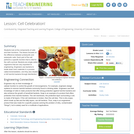
In this lesson, the students look at the components of cells and their functions. The lesson focuses on the difference between prokaryotic and eukaryotic cells. Each part of the cell performs a specific function that is vital for the cell's survival. Bacteria are single-celled organisms that are very important to engineers. Engineers can use bacteria to break down toxic materials in a process called bioremediation, and they can also kill or disable harmful bacteria through disinfection.

This cell crossword puzzle uses vocabulary from CELLS alive! If you have trouble, use the "Search this Site" engine in the lefthand menu.
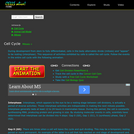
During development from stem to fully differentiated, cells in the body alternately divide (mitosis) and "appear" to be resting (interphase). This sequence of activities exhibited by cells is called the cell cycle. Watch this animation to learn more about each of the stages in the cell cycle: interphase, gap 0, gap 1, S Phase, gap 2, and M phase.

Mechanical forces play a decisive role during development of tissues and organs, during remodeling following injury as well as in normal function. A stress field influences cell function primarily through deformation of the extracellular matrix to which cells are attached. Deformed cells express different biosynthetic activity relative to undeformed cells. The unit cell process paradigm combined with topics in connective tissue mechanics form the basis for discussions of several topics from cell biology, physiology, and medicine.
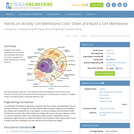
Students color-code a schematic of a cell and its cell membrane structures. Then they complete the "Build-a-Membrane" activity found at http://learn.genetics.utah.edu. This reinforces their understanding of the structure and function of animal cells, and shows them the importance of being able to construct a tangible model of something that is otherwise difficult to see.
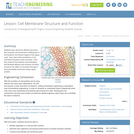
Students learn about the different structures that comprise cell membranes, fulfilling part of the Research and Revise stages of the legacy cycle. They view online animations of cell membrane dynamics (links provided). Then they observe three teacher demonstrations that illustrate diffusion and osmosis concepts, as well as the effect of movement through a semi-permeable membrane using Lugol's solution.

This is a video and supporting worksheet covering membrane transport processes (Chapter 3).

Welcome to 'Cell Membranes - Composition and Passive Transport' ModuleBy the end of this module, students will be able to: - Understand the structure, composition, and function of the cell membrane - Recognize how the membrane effects the rest of the cell and the larger organism- Visualize key concepts through our instructional video- Recall knowledge with our self-quiz of key concepts presented in both the module and the video- Critically apply this information through our in-class activityScroll down for more information on resources available in this module.GIF by Amoeba SistersResources:Cell Membrane Handout (thorough explanation of material, 5 pages long)Cell Membrane Instructional Video (Stuti and Scarlett visually present the process of passive transport)Khan Academy Diffusion and Passive Transport Article With Images (This article provides a shorter summary of Diffusion and Passive Transport with images for visual comprehension.)Cell Membrane Key Concepts & Comprehension Questions (List of key concepts presented in the Handout and Video, followed by comprehension questions)Cell Membrane Self-Quiz (Test your memorization of key concepts)Cell Membrane In-class Activity (Apply your knowledge of key concepts to the greater picture)Answer Key for In-class Activity (Compare your answers, and work on problems areas with Cell Membrane Handout, Key Concepts, or Video.)Cell Membrane Case Study (Evaluate your knowledge by applying it to this case study about how passive transport relates to digestion and diarrhea.)Website, resources, and content created by Stuti Patel, Ifrah Raja, Rubiya Dhillon, Kate Wilcox, and Scarlett Leon.
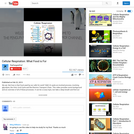
Video tutorial for cellular respiration: overview, glycolysis, citric acid cycle and electron transport chain.
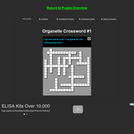
This cell structure crossword puzzle uses vocabulary from CELLS alive! If you have trouble and need a hint, use the "Search this Site" engine in the lefthand menu. Good Luck!
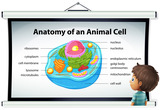
This interactive lesson can be used by students to learn or review and practice animal and plant cell structures and function.

In this unit, students look at the components of cells and their functions and discover the controversy behind stem cell research. The first lesson focuses on the difference between prokaryotic and eukaryotic cells. In the second lesson, students learn about the basics of cellular respiration. They also learn about the application of cellular respiration to engineering and bioremediation. The third lesson continues students' education on cells in the human body and how (and why) engineers are involved in the research of stem cell behavior.

This chapter explains what a cell is and how it functions.

Students learn about complex networks and how to represent them using graphs. They also learn that graph theory is a useful mathematical tool for studying complex networks in diverse applications of science and engineering, such as neural networks in the brain, biochemical reaction networks in cells, communication networks, such as the internet, and social networks. Topics covered include set theory, defining a graph, as well as defining the degree of a node and the degree distribution of a graph.

This lesson introduces students to the idea of biomimicry or looking to nature for engineering ideas. Biomimicry involves solving human problems by mimicking natural solutions, and it works well because the solutions exist naturally. There are numerous examples of useful applications of biomimicry, and in this lesson we look at a few fun examples.

Students learn about biomedical engineering while designing, building and testing prototype surgical tools to treat cancer. Students also learn that if cancer cells are not removed quickly enough during testing, a cancerous tumor may grow exponentially and become more challenging to eliminate. Students practice iterative design as they improve their surgical tools during the activity.
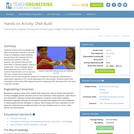
Students reinforce their knowledge that DNA is the genetic material for all living things by modeling it using toothpicks and gumdrops that represent the four biochemicals (adenine, thiamine, guanine, and cytosine) that pair with each other in a specific pattern, making a double helix. They investigate specific DNA sequences that code for certain physical characteristics such as eye and hair color. Student teams trade DNA "strands" and de-code the genetic sequences to determine the physical characteristics (phenotype) displayed by the strands (genotype) from other groups. Students extend their knowledge to learn about DNA fingerprinting and recognizing DNA alterations that may result in genetic disorders.
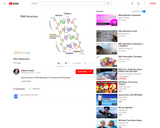
Short video covering DNA replication for anatomy and physiology.